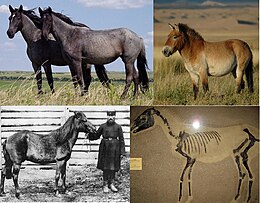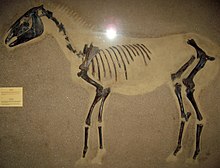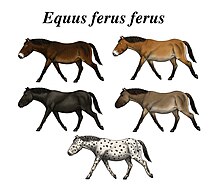Wild horse
| Wild horse | |
|---|---|

| |
| Top left: Equus ferus przewalskii (Przewalski's horse)Below left: | |
| Scientific classification | |
| Domain: | Eukaryota |
| Kingdom: | Animalia |
| Phylum: | Chordata |
| Class: | Mammalia |
| Order: | Perissodactyla |
| Family: | Equidae |
| Genus: | Equus |
| Subgenus: | Equus
|
| Species: | E. ferus
|
| Binomial name | |
| Equus ferus Boddaert, 1785
| |
| Subspecies | |
| |
The wild horse (Equus ferus) is a
Other subspecies of Equus ferus may have existed and could have been the stock from which domesticated horses are descended.
The term "wild horse" is also used colloquially in reference to free-roaming herds of feral horses; for example, the mustang in the United States,[15] and the brumby in Australia.[16] These feral horses are untamed members of the domestic horse (Equus caballus), not to be confused with the truly "wild" horse subspecies extant into modern times.
Distribution
Evidence supports E. ferus as having evolved in
By the latest Pleistocene or early
Ecology
In general, wild horses are
Subspecies and their history
E. ferus has had several subspecies, those of which survived into modern times are:[25]
- The domesticated horse (Equus ferus caballus).
- The Eurasian wild horse (Equus ferus ferus), incorrectly listed as Equus caballus ferus in MSW 3; originally considered synonymous with the tarpan, though recent research has cast doubt on this. Horses identified as tarpans were found in Europe and western Asia before the last surviving animals —possibly hybrids by that time — became effectively extinct in the late 19th century. The last specimen died in 1909 whilst in captivity in an estate in Poltava Governorate, Russian Empire.
- Przewalski's horse (Equus ferus przewalskii), incorrectly listed as Equus caballus przewalskii in MSW 3; also known as the Mongolian wild horse or takhi, it is native to Central Asia and the Gobi Desert. It is sometimes considered its own species, Equus przewalskii.
The latter two are the only never-domesticated "wild" groups that survived into historic times. However, other subspecies of Equus ferus may have existed.[7]
In the
Evolutionary history and taxonomy


The horse family
Currently, three subspecies that lived during recorded human history are recognized.[25] One subspecies is the widespread domestic horse (Equus ferus caballus),[25] as well as two wild subspecies: the recently extinct European wild horse (E. f. ferus) and the endangered Przewalski's horse (E. f. przewalskii).[10][11][25]
Genetically, the pre-domestication horse, E. ferus, and the domesticated horse, E. caballus, form a single homogeneous group (clade) and are genetically indistinguishable from each other.[29][34][35][36] The genetic variation within this clade shows only a limited regional variation, with the notable exception of Przewalski's horse.[29][34][35][36] Przewalski's horse has several unique genetic differences that distinguish it from the other subspecies, including 66 instead of 64 chromosomes,[10][37] unique Y-chromosome gene haplotypes,[38] and unique mtDNA haplotypes.[39][40]
Besides genetic differences, osteological evidence from across the Eurasian wild horse range, based on cranial and metacarpal differences, indicates the presence of only two subspecies in postglacial times, the tarpan and Przewalski's horse.[7][41]
Scientific naming of the species
In some sources including MSW 3 (2005), the domesticated and wild horses were considered a single species, with the valid scientific name for such a single horse species being Equus ferus,[42] although MSW erroneously used E. caballus for this (enlarged) taxon on account of a mis-interpretation of the then-recent ICZN ruling on the matter,[43] refer Groves & Grubb, 2011.[44] The wild tarpan subspecies is E. f. ferus, Przewalski's horse is E. f. przewalskii, while the domesticated horse is nowadays normally (but not exclusively) treated as a separate species E. caballus. The rules for the scientific naming of animal species are determined in the International Code of Zoological Nomenclature, which stipulates that the oldest available valid scientific name is used to name the species.[45] Previously, when taxonomists considered domesticated and wild horse two subspecies of the same species, the valid scientific name was Equus caballus Linnaeus 1758,[46] with the subspecies labeled E. c. caballus (domesticated horse), E. c. ferus Boddaert, 1785 (tarpan) and E. c. przewalskii Poliakov, 1881 (Przewalski's horse).[47] However, in 2003, the International Commission on Zoological Nomenclature decided that the scientific names of the wild species have priority over the scientific names of domesticated species, therefore mandating the use of Equus ferus for both the wild and the domesticated horse if the two taxa are considered conspecific.[48]
Przewalski's horse

In 2018, a DNA study revealed that the horses found associated with the Botai culture were Przewalski's horses, raising the question of whether these animals were an isolated population, if extant Przewalski horses today represent feral descendants, or if the domestication attempt at Botai failed. [54] A 2021 study noted that arrowheads were found in conjunction with some Botai horse remains, suggesting these horses were hunted, rather than domesticated, and thus the question remains unresolved.[55]
Przewalski's horse is still found today, though it is an endangered species and for a time was considered extinct in the wild.[40] Roughly 2000 Przewalski's horses are in zoos around the world.[56] A small breeding population has been reintroduced in Mongolia.[57][58] As of 2005, a cooperative venture between the Zoological Society of London and Mongolian scientists has resulted in a population of 248 animals in the wild.[59]
Przewalski's horse has some biological differences from the domestic
Feral horses

Horses that live in an untamed state but have ancestors that have been
In 1995, British and French explorers encountered a new population of horses in the
See also
References
Citations
- . Retrieved 17 February 2022.
- OCLC 62265494.
- ^ "Explore the Database". www.mammaldiversity.org. Retrieved 20 August 2021.
- ISBN 3-89432-913-0
- ^ "Tarpan". Britannica. Retrieved 7 March 2023.
- ^ "The Przewalskii and Tarpan Horses". Retrieved 7 March 2023.
- ^ a b c Colin Groves, 1986, "The taxonomy, distribution, and adaptations of recent Equids", In Richard H. Meadow and Hans-Peter Uerpmann, eds., Equids in the Ancient World, volume I, pp. 11-65, Wiesbaden: Ludwig Reichert Verlag.
- ^ Goldman, Jason G. "10 Things You Didn't Know About Przewalski's Horses". Scientific American Blog Network.
- ^ "The First Horses: The Przewalskii and Tarpan Horses", The legacy of the horse, International Museum of the Horse, archived from the original on 30 October 2007, retrieved 18 February 2009
- ^ State University of New York Press.
- ^ .
- ISBN 978-0-85199-429-1.
- ^ "Tarpan or Heck Horse". horsehints.org.
- ^ "Rare horse breed proves crucial to delicate ecosystem - Features". Horsetalk.co.nz. 1 June 2012. Archived from the original on 9 November 2020. Retrieved 28 May 2017.
- ^ "Black Hills Wild Horse Sanctuary". Black Hills Wild Horse Sanctuary.
- ^ "The Brumbies – Australian Wild Horses › Wild Horses and Mustangs .com". www.wildhorsesandmustangs.com.
- ^ PMID 26177104.
- ^ Kirkpatrick, Jay F.; July 2008, Patricia M. Fazio 24 (24 July 2008). "The Surprising History of America's Wild Horses". livescience.com. Retrieved 11 October 2020.
{{cite web}}: CS1 maint: numeric names: authors list (link) - S2CID 195656032.
- S2CID 19069554.
- ^ Kateryna Slivinska; Grzegorz Kopij (2011). "Diet of the Przewalski's horse Equus przewalskii in the Chernobyl Exclusion Zone" (PDF). Polish Journal of Ecology. 59 (4): 841–847. Archived from the original (PDF) on 29 October 2013. Retrieved 29 October 2013.
- S2CID 85877321.
- ^ Philipps, Dave (12 May 2018). "Let Mountain Lions Eat Horses". The New York Times.
- ^ "Brown Hyena Research Project - The Spotted Hyena". 8 August 2013. Archived from the original on 8 August 2013.
- ^ a b c d Don E. Wilson; DeeAnn M. Reeder, eds. (2005). "Equus caballus". Mammal Species of the World. A Taxonomic and Geographic Reference (3rd ed.). Johns Hopkins University Press. Retrieved 12 February 2009.
- ISSN 2296-701X.
- PMID 22065780.
- ^ "Equus caballus [ISC] (horse)". www.cabi.org.
- ^ PMID 15974804.
- PMID 28817644.
- PMID 29182148.
- .
- PMID 25762573.
- ^ S2CID 19069554.
- ^ .
- ^ S2CID 15514589. Archived from the original(PDF) on 5 July 2020.
- S2CID 21562513.
- PMID 18931383.
- PMID 12130666.
- ^ a b "Equus ferus ssp. przewalskii (Asian Wild Horse, Mongolian Wild Horse, Przewalski's Horse)". IUCN Red List of Threatened Species.
- ^ Eisenmann, Vera (1998). "Quaternary Horses: possible candidates to domestication". The Horse: its domestication, diffusion and role in past communities. Proceedings of the XIII International Congress of Prehistoric and Protohistoric Sciences, Forli, Italia, 8–14 September 1996. Vol. 1. ABACO Edizioni. pp. 27–36.
- ISBN 978-1118708064.
- ^ International Commission on Zoological Nomenclature (2003). "Usage of 17 specific names based on wild species which are pre-dated by or contemporary with those based on domestic animals (Lepidoptera, Osteichthyes, Mammalia): conserved. Opinion 2027 (Case 3010)". Bull. Zool. Nomencl. 60 (1): 81–84.
- ISBN 978-1-4214-0093-8
- ^ "Principles of nomenclature of zoological taxa". www.insecta.bio.spbu.ru. Archived from the original on 29 July 2017. Retrieved 28 May 2017.
- ^ Linnaeus, Carolus (1758). Systema naturae per regna tria naturae :secundum classes, ordines, genera, species, cum characteribus, differentiis, synonymis, locis. Vol. 1 (10th ed.). Holmiae (Laurentii Salvii). p. 73. Retrieved 30 January 2009.
- ^ Bunzel-Drüke, Margret. "Ecological substitutes for Wild horse and Aurochs" (PDF). Natur- und Kulturlandschaft, Höxter/Jena 2001, Band 4: 10. Archived from the original (PDF) on 3 March 2016. Retrieved 28 May 2017.
- .
- ISBN 9780300096880.
- ^ WAZA. "Overview : WAZA : World Association of Zoos and Aquariums". www.waza.org. Archived from the original on 3 June 2017. Retrieved 28 May 2017.
- S2CID 11932020. Archived from the original(PDF) on 6 July 2020.
- PMID 15034578.
- hdl:10230/33065.
- PMID 29472442.
- ^ William Timothy Treal Taylor and Christina Isabelle Barrón‑Ortiz: Rethinking the evidence for early horse domestication at Botai. Scientific Reports 11, 2021, S. 7440, doi:10.1038/s41598-021-86832-9
- ^ Gallagher, Paige Williams , Sean. "The Remarkable Comeback of Przewalski's Horse". Smithsonian.
{{cite news}}: CS1 maint: multiple names: authors list (link) - ^ "Przewalski's Horse". si.edu. Retrieved 8 June 2015.
- ^ "Endangered Przewalski's Horses Back On Russian Steppe". RadioFreeEurope/RadioLiberty.
- ^ "An extraordinary return from the brink of extinction for worlds last wild horse" Archived 2006-07-22 at the Wayback Machine ZSL Living Conservation, December 19, 2005.
- ISBN 9781118522127.
- ^ The American Museum of Natural History When Is a Wild Horse Actually a Feral Horse?
- ^ a b "Are There Still Wild Horses?".
- PMID 16489143.
- ^ Rittman, Paul. "Spanish Colonial Horse and the Plains Indian Culture" (PDF). Archived from the original (PDF) on 12 April 2019. Retrieved 18 January 2015.
- S2CID 26285264. Archived from the original(PDF) on 5 July 2020.
- ^ "Wildlife". Cumberland Island. Retrieved 20 November 2015.
- ISSN 0362-4331.
- ISBN 978-0-300-08880-9.
- ^ ISBN 9780312309534.
- ^ Humi, Peter (17 November 1995). "Tibetan discovery is 'horse of a different color'". CNN. Archived from the original on 3 December 2014. Retrieved 9 September 2009.
Bibliography
- Equid Specialist Group 1996. Equus ferus. In: IUCN 2006. 2006 IUCN Red List of Threatened Species. <www.iucnredlist.org>. Downloaded on 22 May 2006 from [1][permanent dead link].
- Moelman, P.D. 2002. Equids. Zebras, Asses and Horses. Status Survey and Conservation Action Plan. IUCN/SSC Equid Specialist Group. IUCN, Gland, Switzerland.
- Ronald M. Nowak (1999), Walker's Mammals of the World (6th ed.), Baltimore: Johns Hopkins University Press, LCCN 98023686

